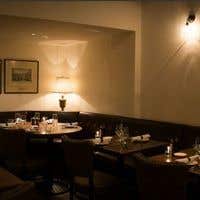This article was also published in the Financial Times.
The clock on the back bar of Cafe Murano, which chef Angela Hartnett and restaurateur Chris Yates opened at 33 St James's Street two months ago, had just turned 2.30 pm, marking another phase in every restaurant's working day.
Right on cue, because deliveries are never accepted during the lunch service, the front door opened and a small wine delivery was taken in by the receptionist. The front door opened again seconds later to reveal this time a young female cook at the start of her evening shift. She walked past the tables, said hello to a couple of the waiters and then headed down to the basement kitchen run by head chef Samantha Williams.
A few minutes later, Yates walked in. He checked in with his receptionist, spoke to a couple of tables and then stopped by our table to enquire whether we had enjoyed our lunch of minestrone, osso buco with risotto Milanese and ox cheeks with polenta.
Yates and I then embarked on a discussion as to which of us could more clearly remember the number and names of all the various restaurants that have occupied this site over the past 20 years. My friend, himself in the property world, seemed fascinated by these reminiscences, so I subsequently went off to discover the facts: what lay behind these numerous different restaurants, of which Cafe Murano is the sixth incarnation in two decades, and, most pertinently, why the earlier ones had not prospered.
In the mid 1990s, this building was an art gallery whose then owner decided that he wanted to be a restaurateur. It was converted, named 33 St James's after its address, but did not survive too long despite producing good food. It lacked a restaurateur's touch and any sense of warmth from the art on the wall.
It was when it then became the first home for Petrus restaurant that the building entered its most prestigious era as chef Marcus Wareing made it his home for very formal French food, then very much à la mode. Wareing and Petrus were then made an offer they could not refuse by the Savoy Group and whisked off to an even more glamorous location within the Berkeley Hotel.
Petrus became Fleur, an undistinguished brasserie out of place then in a rather posh location, and when it closed, in stepped canny restaurateur Claudio Pulze. He appreciated its potential but despite transforming it into two very different restaurants, initially as Fiore with a talented chef whom Pulze imported from Italy, and then as Brasserie St Jacques at the outset in partnership with chef Pierre Koffmann, he never managed to replicate the success here that he has achieved over an even longer period with Al Duca restaurant that is no more than 300 metres away on Duke Street.
Over the years, Pulze explained, he probably just about broke even running this restaurant. He certainly didn't believe it was 'a jinxed site' but when the lease reverted to the Crown Estate, as the freeholder, he chose to bow out. In stepped Hartnett and Yates, who had worked together before, in what has the hallmarks of a mutually beneficial arrangement. The Crown Estate has the association with a well-known female chef while Hartnett has the opportunity to establish a lower priced and more relaxed sibling to her Murano restaurant only a short walk away to the north of Piccadilly.
In establishing the appropriate setting for such a restaurant, Hartnett, Yates and their designer Russell Sage have done a first-class job. The most obvious physical change has come about with the removal of the wine cellar at the far end of the room. In its place Sage has created two levels for dining tables with the flexibility to use the far area as a semi-private dining area. The other major change is borrowed from Le Caprice and Cecconi's nearby in that a large counter has been installed in front of the bar where the full menu is now served. The absence of tablecloths, and waiting staff in smart jeans, shirts, ties and aprons are standard fare today.
The overall effect of all these changes is that for the very first time in its chequered history, this dining room can now seat between 75 and 80 and has an air of jollity about it. There is a good feel to it and the acoustics are fine, too. Cafe Murano, finally, has the potential to please – something its predecessors, even the formal Petrus, never did.
But to tempt me back, I do feel that Hartnett and Williams need to up their game. The delight of Italian dishes at this level that include seemingly simple classics such as vitello tonnato, ham minestrone, linguine with cockles, and risotto Milanese is that they transmit their flavours so immediately and so directly. But I never felt this with what we ate during my two meals here – and certainly not with our desserts, a tiramisu, a warm prune and almond cake and a pannacotta with oranges, which lacked conviction and distinction.
Hartnett and Williams don't have to travel to Italy for inspiration because across London, in Bermondsey, SE1, the kitchen at Zucca in is producing precisely this. A Cafe Murano of stronger flavours would then have all the prerequisites to flourish.
Café Murano 33 St James's Street, London SW1A 1HD; tel +44 (0)20 3371 5559
£60 per head with wine. Closed Sunday.
The photo is taken from the Cafe Murano website.

